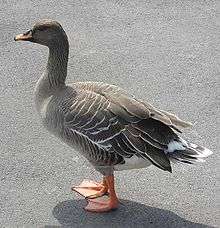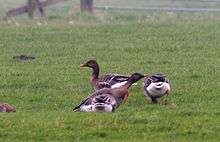Bean goose
| Bean goose | |
|---|---|
 | |
| Bean goose at Slimbridge Wildfowl and Wetlands Centre, Gloucestershire, England | |
| Scientific classification | |
| Kingdom: | Animalia |
| Phylum: | Chordata |
| Class: | Aves |
| Order: | Anseriformes |
| Family: | Anatidae |
| Subfamily: | Anserinae |
| Tribe: | Anserini |
| Genus: | Anser Brisson, 1760 |
| Species | |
|
Taiga bean goose (Anser fabalis) | |
The bean goose is a goose that breeds in northern Europe and Asia. It has two distinct varieties, one inhabiting taiga habitats and one inhabiting tundra. These are recognised as separate species by the American Ornithologists' Union and the IOC (taiga bean goose and tundra bean goose), but are considered a single species by other authorities, such as the British Ornithologists' Union. It is migratory and winters further south in Europe and Asia.
Description
The length ranges from 68 to 90 cm (27–35 in), wingspan from 140 to 174 cm (55–69 in) and weight from 1.7–4 kg (3.7–8.8 lb).[2] In the nominate subspecies, males average 3.2 kg (7.1 lb) and females average 2.84 kg (6.3 lb).[2] The bill is black at the base and tip, with an orange band across the middle; the legs and feet are also bright orange.
The upper wing-coverts are dark brown, as in the white-fronted goose (Anser albifrons) and the lesser white-fronted goose (A. erythropus), but differing from these in having narrow white fringes to the feathers.
The voice is a loud honking, higher pitched in the smaller subspecies.
The closely related pink-footed goose (A. brachyrhynchus) has the bill short, bright pink in the middle, and the feet also pink, the upper wing-coverts being nearly of the same bluish-grey as in the greylag goose. In size and bill structure, it is very similar to Anser fabalis rossicus, and in the past was often treated as a sixth subspecies of bean goose.
Taxonomy
The English and scientific names of the bean goose come from its habit in the past of grazing in bean field stubbles in winter. Anser is the Latin for "goose", and fabalis is derived from the Latin faba, a broad bean.[3]


There are five subspecies, with complex variation in body size and bill size and pattern; generally, size increases from north to south and from west to east. Some ornithologists (including AOU 2007) split them into two species based on breeding habitat, whether in forest bogs in the subarctic taiga, or on the arctic tundra.
- Taiga bean goose (Anser fabalis sensu stricto) (Latham, 1787)
- A. f. fabalis (Latham, 1787). Scandinavia east to the Urals. Large; bill long and narrow, with broad orange band. Anser fabalis fabalis is one of the species to which the Agreement on the Conservation of African-Eurasian Migratory Waterbirds (AEWA) applies.
- A. f. johanseni (Delacour, 1951). West Siberian taiga. Large; bill long and narrow, with narrow orange band.
- A. f. middendorffii (Severtzov, 1873). East Siberian taiga. Very large; bill long and stout, with narrow orange band.
- Tundra bean goose (Anser serrirostris, if treated as a distinct species) (Gould, 1852)
- A. s. rossicus (Buturlin, 1933). Northern Russian tundra east to the Taimyr Peninsula. Small; bill short and stubby, with narrow orange band. Anser fabalis rossicus is one of the species to which the Agreement on the Conservation of African-Eurasian Migratory Waterbirds (AEWA) applies.
- A. s. serrirostris (Gould, 1852). East Siberian tundra. Large; bill long and stout, with narrow orange band.
Distribution
The bean goose is a rare winter visitor to Britain. There are two regular wintering flocks of taiga bean goose, in the Yare Valley, Norfolk and the Avon Valley, Scotland. A formerly regular flock in Dumfries and Galloway no longer occurs there. The tundra bean goose has no regular wintering sites, but is found in small groups among other grey goose species – among the most regular localities are WWT Slimbridge, Gloucestershire and Holkham Marshes, Norfolk.
The Taiga bean geese Anser fabalis fabalis wintering in Europe are considered to migrate across three different flyways: Western, Central and Eastern; which has been confirmed by stable isotope analysis of their flight feathers.[4]
References
- ↑ BirdLife International (2012). "Anser fabalis". IUCN Red List of Threatened Species. Version 2014.3. International Union for Conservation of Nature. Retrieved 4 January 2015.
- 1 2 Dunning, John B. Jr., ed. (1992). CRC Handbook of Avian Body Masses. CRC Press. ISBN 978-0-8493-4258-5.
- ↑ Jobling, James A (2010). The Helm Dictionary of Scientific Bird Names. London: Christopher Helm. pp. 48, 157. ISBN 978-1-4081-2501-4.
- ↑ Fox, A. D.; Hobson, K. A.; de Jong, A.; Kardynal, K. J.; Koehler, G.; Heinicke, T. (2017). "Flyway population delineation in Taiga Bean Geese Anser fabalis fabalis revealed by multi-element feather stable isotope analysis". Ibis. 159 (1): 66–75. doi:10.1111/ibi.12417.
Further reading
- Sangster, George; Oreel, Gerald J. (1996). "Progress in taxonomy of Taiga and Tundra Bean Geese". Dutch Birding. 18 (6): 310–316.
- Oates, John (1997). "Identification of Taiga Bean Goose and Tundra Bean Goose". Birding World. 10 (11): 421–426.
- Ruokonen, M.; Litvin, K.; Aarvak, T. (2008). "Taxonomy of the bean goose - pink-footed goose". Molecular Phylogenetics and Evolution. 48: 554–562. doi:10.1016/j.ympev.2008.04.038. PMID 18550388.
- Brown, Dan (2010). "Identification and taxonomy of bean geese". Birding World. 23 (3): 110–121.
External links
| Wikimedia Commons has media related to Anser fabalis. |
| Wikispecies has information related to Anser fabalis |
- RSPB Birds by Name – Bean Goose
- BirdGuides Bean Goose Page
- Cyberbirding: Bean Goose pictures
- BirdLife species factsheet for Anser fabalis
- "Anser fabalis". Avibase.
- "Bean goose media". Internet Bird Collection.
- Interactive range map of Anser fabalis at IUCN Red List maps
- Audio recordings of Taiga Bean goose on Xeno-canto.
